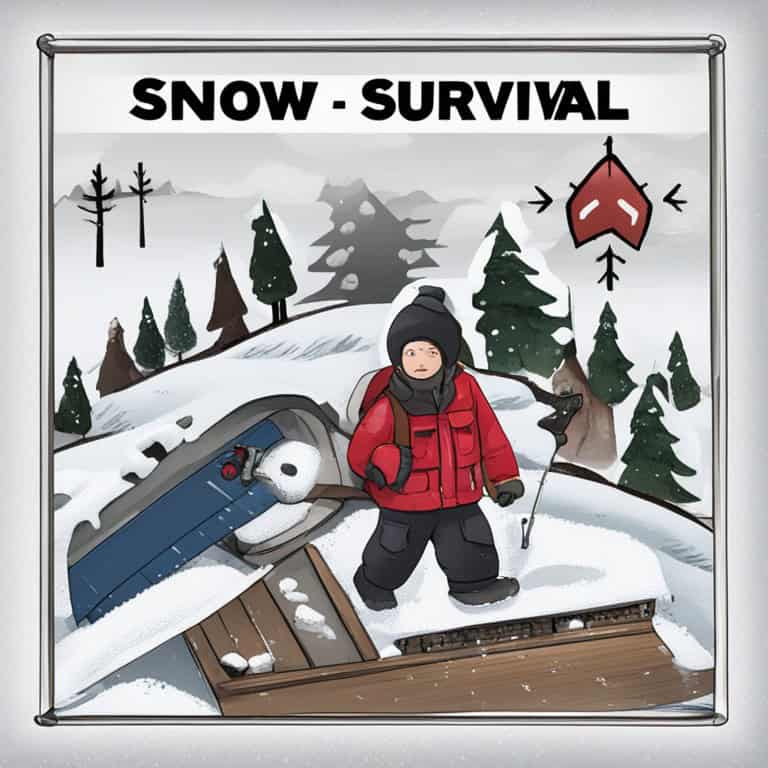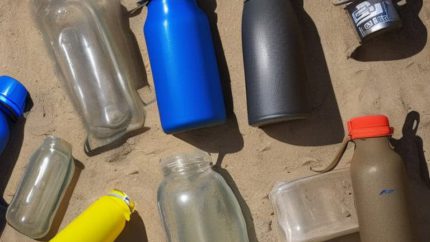Snow Survival
Nothing is more difficult to survive in extreme conditions than harsh winter surroundings. On the other hand, nature provides a magnificent solution concealed in plain sight: snow. In this blog post, we'll look at the great advantages of snow for survivalists. Snow might be your most beneficial ally in the frozen wilderness, from emergency shelter construction and water sourcing to navigation tactics and food preparation.
Building Emergency Shelters: Harnessing the Power of Snow
Snow's tremendous potential as a building material becomes clear in the face of unexpected blizzards or chilly nights. This simple white, powdered substance can be transformed into a vital resource for building emergency shelters. The idea is to use snow's unique qualities as a natural insulator, capable of keeping warm air within its crystalline structure while warding off the stinging cold.
The building of snow caves is an ingenious approach to utilizing snow for emergency shelter. Individuals can carve a protective alcove into a snowbank to take advantage of the insulating characteristics of the surrounding snow. Similarly, the classic igloo serves as a functional snow-based shelter. Its domed construction, made of compacted snow blocks, provides a cozy haven and protects people from the elements.
Snow trenches provide a potential alternative for those looking for a less traditional approach. Individuals can dig into the snow to make long, narrow shelters that serve as windbreaks and insulate against the biting cold. Snow's versatility as a building material provides for adaptation to many terrains and weather situations.
Snow's strength in building emergency shelters stems from its dual role as a raw resource and a natural insulator. Individuals can quickly and resourcefully create protective structures that stand robust against nature's cruel forces by mastering techniques such as snow caves, igloos, or snow trenches.

Natures Frozen Water Source for Survival
Nature gives an unexpected ally in the form of snow in the brutal embrace of cold weather when the quest for a reliable water supply becomes a hard battle. Beyond its lovely white blanket, snow reveals itself as an essential frozen reserve that can be used for survival. Individuals confronted with frozen environments can turn to snow as a practical answer because they recognize the importance of life that water represents.
The process is deceptively simple but profound: gathering and melting fresh snow. In situations where drinking water is limited, this natural source of hydration provides a lifeline. The trick is to handle the snow with care, ensuring that the resulting liquid is free of impurities that could endanger health. Although snow appears immaculate, it can harbor pollutants, necessitating a thorough filtration and purifying process.
Snow must be packed into a container and heated before consumption. This one gesture begins a revolutionary journey, transforming frozen crystals into life-sustaining water. However, the melting process is only the beginning. Using filtration and purification procedures to protect against potential risks such as waterborne infections is critical. This two-step process recognizes the inherent purity of snow and assures that the resulting water is safe to drink.
Snow becomes more than a scenic feature in the hands of competent humans confronted with the hardships of frigid environments; it grows into a dynamic source of survival. Gathering, melting, and purifying snow is a simple yet significant act that can reveal a liquid lifeline that resists the harshness of the winter. The conversion of nature's frozen water into a dependable source of clean hydration demonstrates human resilience and resourcefulness in the face of harsh conditions.
Frostbite Prevention: Utilizing Snow to Keep Warm
The fear of frostbite looms large for those facing the weather. Surviving in harsh cold necessitates ingenuity, and one such approach involves relying on the very element that blankets the terrain – snow. Using snow as a natural insulator for exposed body parts is an excellent and surprisingly simple way to avoid frostbite.
Frostbite occurs when the skin and underlying tissues freeze as a result of prolonged exposure to cold temperatures, resulting in blood vessel constriction and potential tissue damage. Preventing this chilling outcome becomes critical, and snow appears as an adaptable ally in the fight against the bitter cold. The method is simple: use snow to build a protective covering around susceptible body parts like hands and feet.
By stuffing gloves, socks, or any other accessible fabric with snow, you can create makeshift insulation. This strategy takes advantage of snow's insulating characteristics, which trap air within its crystalline structure, producing a barrier against freezing temperatures. The snow-packed fabric conforms to the body's curves, forming a snug and safe cocoon that effectively retains body heat.
The beauty of this approach is its ease of use and speed. Readily available snow becomes a vital resource in chilly climates with limited traditional heating options. The insulating effect of snow-filled clothes aids in the maintenance of a critical balance between the body's heat production and the relentless cold, considerably lowering the risk of frostbite.
This technique also emphasizes the significance of adaptability in survival situations. Nature supplies resilient tools, and the capacity to reuse snow as a protective layer demonstrates the creativity inherent in human survival instincts. In the face of extreme cold, a handful of snow transforms from a frozen landscape element to an active instrument in the fight against frostbite.
Creating a Cozy Winter Shelter
Following the successful construction of your emergency shelter in the harsh winter terrain, the next crucial stage is to master the art of snow insulation. Effective insulation is critical for survival, and snow, which is frequently viewed as only an exterior element, emerges as a versatile ally in keeping a warm and secure shelter.
The insulating characteristics of snow are due to its particular composition. Snow acts as a natural thermal barrier due to the numerous air pockets trapped inside its crystalline structure. Cover the walls and roof of your shelter with a thick coating of snow to maximize insulation. This snow-covered surface functions as a powerful screen, preventing heat loss from within and, as a result, creating a cozy haven from the bitter cold outside.
The positioning of snow around your shelter serves two purposes. It not only provides insulation but also strengthens the structural integrity of your improvised home. The weight of the snow works as a stabilizing force, anchoring the shelter against anticipated wind gusts or other environmental problems. This symbiotic interaction between snow's insulating and stabilizing characteristics helps to the shelter's overall robustness.
However, while enjoying the protective qualities of snow, exercise caution. Adequate ventilation is critical to preventing carbon dioxide buildup within the shelter. While snow provides insulation, a closed environment with little airflow can cause respiratory problems. Create purposeful apertures or vents in your shelter to allow for a controlled flow of air while retaining the insulating benefits of the surrounding snow.
Navigating the Frozen Terrain
In the vast, snow-covered wilderness, navigation may quickly become daunting, converting the tranquil environment into a possible maze of confusion and danger. Snow may go from a simple covering to a helpful compass, leading survivalists through the frozen environment with the correct abilities. The goal is to recognize and evaluate snow's tiny but informative characteristics.
The unique patterns of drifts are one of the major elements to utilize in snow navigation. Wind bends these drifts in predictable ways, creating slopes and patterns that can be used to determine direction. Observing the angle and shape of these drifts provides significant information about the prevailing wind directions, which aids with orienting. This expertise is especially important in wide, featureless stretches when icy terrain may conceal traditional landmarks.
Frozen streams and bodies of water provide yet another navigational hint. The freezing process can disclose the direction of the water flow, assisting in orientation. Furthermore, the thickness and quality of the ice can provide information about the overall temperature and associated environmental hazards. A frozen stream can serve as more than just a scenic feature; it can also serve as a navigational tool, showing the direction and state of the landscape.
Animal tracks in the snow provide a dynamic map of wildlife migration. Deciphering these traces allows one to discover potential sources of water, find refuge, and even predict the arrival of predators. Animals that have adapted to their circumstances will take the path of least resistance, providing subtle but vital guidance to human navigators.
Learning to read the snow requires scientific observation as well as an intimate awareness of the natural world. It is about understanding not only the physical features of snow but also the narrative it conveys about the environment. The snow transforms into a living medium, catching the history of wind, water, and wildlife and translating it into a guide for people traveling the frozen environment.
Survival Food: Unleashing the Potential of Snow Cuisine
The resourceful survivalist uncovers a hidden gourmet world in the seemingly barren stretches of snow-covered terrain, where snow becomes more than just a frozen canvas; it becomes a versatile component in the art of snow cuisine. The apparent desolation transforms into a bountiful abundance for those who understand how to utilize the potential of snow for nutrition.
Making snow soups is an amazing approach to using snow in survival food. While it may seem strange, snow may be used to make a healthy soup. Melting it over a heat source produces a basic yet effective liquid that can be supplemented with other components if they are available. The controlled melting of snow provides a safe source of drinking water, addressing both hydration and nutritional demands.
Snow's importance extends beyond liquid sustenance to food storage. The use of packed snow to build containers provides a natural and insulated environment for storing food, plants and animals. These snow containers function as improvised refrigerators, utilizing the insulating characteristics of snow to maintain a steady temperature that aids in spoiling prevention. This method is especially useful in situations where traditional refrigeration is not an option.
When combined with the usage of snow, the landscape itself can provide gastronomic delights. Snow can be a useful foraging tool since it reveals hidden plants and vegetation that would otherwise be obscured. By carefully accumulating snow around these natural delicacies, a protective layer against the cold is created, providing a temporary storage solution and extending the availability of food supplies.
Snow can be used as a culinary utensil for cooking in addition to its significance in food preparation and preservation. Making snow ovens or steamers enables the preparation of a greater variety of meals, increasing the diversity and nutritional value of a survivalist's diet. The regulated application of heat to snow enables culinary procedures that respond to environmental constraints.
Snow Tools: Crafting Essential Implements for Your Survival Kit
Snow's utility goes beyond insulation and shelter construction; with a little initiative and resourcefulness, it can be transformed into a diverse medium for making important survival equipment. Snow becomes the raw material for a variety of implements that can be crucial in navigating and living in the harsh winter wilderness in the hands of an experienced survivalist.
The makeshift snow shovel is one of the most basic yet important snow equipment. Making a shovel out of compacted snow enables efficient snow removal, whether for shelter construction, clearing walkways, or digging snow caves. A snow shovel built from its surroundings is lightweight and portable, making it a useful addition to a survival toolkit.
Cutting tools are necessary for survival, and snow can be fashioned into makeshift knives and blades. A survivalist can construct cutting implements suitable for numerous activities such as carving wood, processing food, or even fashioning other tools from accessible materials by compacting and shaping snow into a sharp edge.
Snow's malleability allows for the building of containers, which can be used to transport and store goods. Snow bowls and cups serve as temporary vessels for collecting and ingesting liquids, providing a practical option in the lack of typical containers. These homemade vessels show the adaptation needed for survival in harsh conditions.
Furthermore, snow can be turned into snowshoes, a clever adaption for deep snow travel. A survivalist can make temporary snowshoes by shaping and compacting snow beneath boots. This distributes weight more evenly, minimizing sinking and allowing for easier movement. While not as durable as regular snowshoes, these improvised versions can be quite useful for conserving energy and navigating difficult terrain.
Though these makeshift snow tools lack the durability of their conventional equivalents, their value resides in their versatility and immediacy. The capacity to create critical instruments from the surrounding environment can be a game changer in desperate conditions. Armed with the skills of shaping snow into functional tools, the ingenious survivalist transforms an apparently harsh winter scene into a workshop of possibilities, illustrating that even the most basic components can become crucial assets in the battle for survival.
The White Canvas: Using Snow for Signaling and Communication
Effective communication can be the crux of survival in a cold environment's vast and sometimes solitary expanses. Snow emerges as a unique and invaluable medium for signaling one's presence to possible rescuers or fellow survivors in such instances. The seemingly monotonous white canvas of snow transforms into a flexible instrument for transmitting messages, marking trails, and increasing visibility in the winter landscape.
Carving huge symbols or characters in the snow is a tried-and-true means of producing visible signals. This method enables survivors to communicate signals or indicators that may be seen from a distance, allowing for communication without the use of spoken words. The juxtaposition of dark symbols against the white snow makes a visually spectacular and attention-grabbing message, whether it's an SOS, an arrow pointing towards safety, or other universally recognized symbols.
Crafting snowman sentinels provides a second purpose by taking snow signaling to a more imaginative level. These snow sculptures not only break up the monotony of the environment but also serve as three-dimensional landmarks. Survivors can establish visible landmarks that serve as aids for navigation by strategically putting them in patterns or along vital pathways. Snowmen's human-like appearance attracts attention and curiosity, making them effective markers on open snow-covered terrains.
To improve visibility, contrast materials can be used. Survivors can construct visible marks or signals by strategically arranging objects of a different color against the white backdrop, such as clothing or equipment. This strategy takes advantage of the dramatic contrast between the brilliant color and the white surroundings, making the signals more visible and increasing the likelihood that they will be detected.
Footprints in the snow provide an additional form of communication. Survivors can convey directional information or identify their presence in an area by purposefully leaving trails or patterns. This kind of communication benefits search and rescue efforts by allowing potential rescuers to follow the track left in the snow.
Essential Tips for Surviving Avalanche-Prone Areas
While snow provides various survival benefits, it is critical to recognize and respect its potential hazards, especially in avalanche-prone places. Navigating these terrains necessitates a thorough awareness of snow safety procedures, including the ability to recognize warning signs, take essential safeguards, and master suitable rescue tactics. Survival in these situations is dependent not only on maximizing the benefits of snow but also on mitigating the threats it offers.
The capacity to recognize warning indicators that precede an avalanche is a vital part of snow safety. Weather conditions, recent snowfall, wind patterns, and slope angle can all contribute considerably to the chance of an avalanche. Cracks or settling sounds in the snowpack, known as “whumpfing,” are another sign that the snowpack is unstable. Educating oneself about these warning indicators becomes a necessary survival skill, allowing individuals to make informed decisions about their routes and activities in avalanche-prone locations.
Preventive actions are very important in snow safety. Traveling with adequate equipment, such as an avalanche transceiver, probe, and shovel, is critical. Practicing rescue scenarios and learning how to utilize this equipment efficiently improves preparation. Additionally, traveling with a buddy with similar experience and equipment adds an extra layer of safety, as a quick and efficient response in the case of an avalanche is critical.
Understanding the terrain is critical. Choosing lower-avalanche-risk routes, avoiding steep slopes, and avoiding locations prone to wind loading can all help to lessen the possibility of initiating an avalanche. Checking avalanche forecasts and actual weather conditions on a regular basis gives useful information for planning safe excursions in snow-covered regions.
Knowing adequate rescue tactics can be lifesaving in the unfortunate event of an avalanche. In avalanche rescues, time is of importance, and quick intervention boosts the likelihood of survival. Individuals caught in an avalanche should use their avalanche airbags (if they have one) and swim to keep near the surface. Survivors must then concentrate on establishing an air pocket around their faces by covering them with their hands, allowing them to breathe while waiting for help.
Survival Poncho Guide: Essential Tips for All Climates
Selecting the Perfect Survival Poncho for Your Needs Understanding Materials and Ensuring Durability Survival Poncho Guide: When choosing the right material for your survival poncho, consider both longevity and effectiveness in challenging situations. Survival ponchos are typically made from a range of materials, such as nylon, polyester, and PVC, each offering distinct levels of durability and waterproofing. […]
Wilderness Fire Safety: Essential Tips and Techniques
Mastering Wilderness Fire Safety Fundamentals What Are the Primary Sources of Wilderness Fires? Wilderness Fire Safety: Wilderness fires can ignite from numerous sources, which are mainly divided into natural and human-induced factors. Among natural causes, lightning strikes are particularly notorious for igniting dry vegetation, especially in remote, arid regions. Under optimal weather conditions, these fires […]
Survival Compass Guide: Essential Tips for Navigation
Mastering Compass Navigation: Essential Knowledge and Techniques What is a Compass and Its Importance? Survival Compass Guide: A compass is an indispensable navigational tool that enables individuals to ascertain direction in relation to the Earth's magnetic poles. This device typically features a magnetised needle that consistently points towards magnetic north, facilitating orientation in unfamiliar terrains. […]
SHTF Hunting Skills: Essential Techniques for Survival
Mastering the Essentials of SHTF Hunting Gaining Insight into Prey Behaviour for Success SHTF Hunting Skills: Understanding the habits and patterns of various animals is fundamental to increasing your chances of a successful hunt. This knowledge is not merely beneficial but essential for survival in any environment, particularly during an SHTF scenario where food sources […]







I appreciate your focus on the often-overlooked benefits of snow in survival scenarios. It’s fascinating how something that might be seen as merely a hindrance in extreme weather can actually serve as such a versatile resource. The concept of constructing snow caves as emergency shelters, for instance, is a testament to our ability to adapt and utilize natural materials effectively.